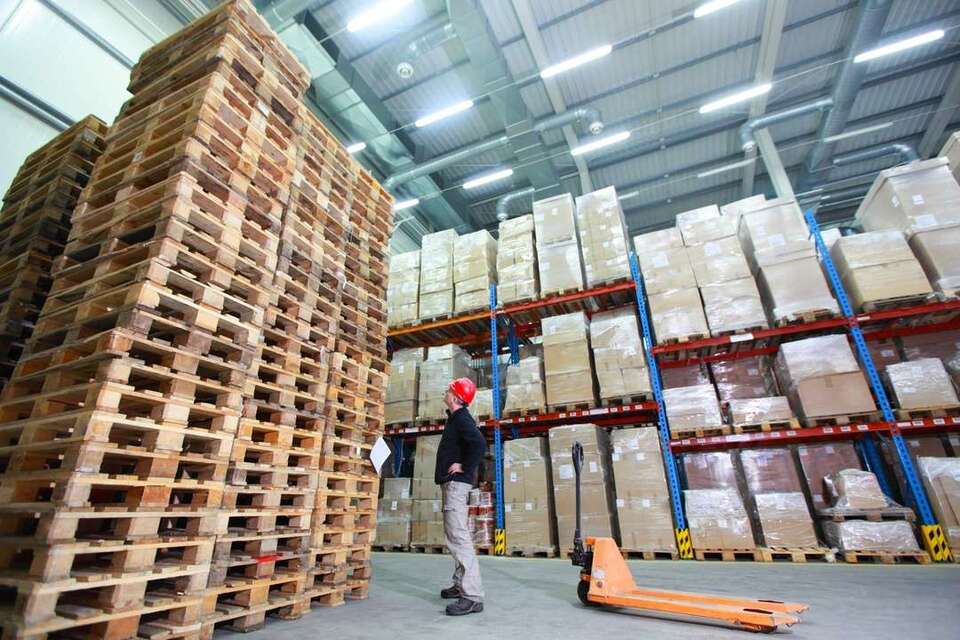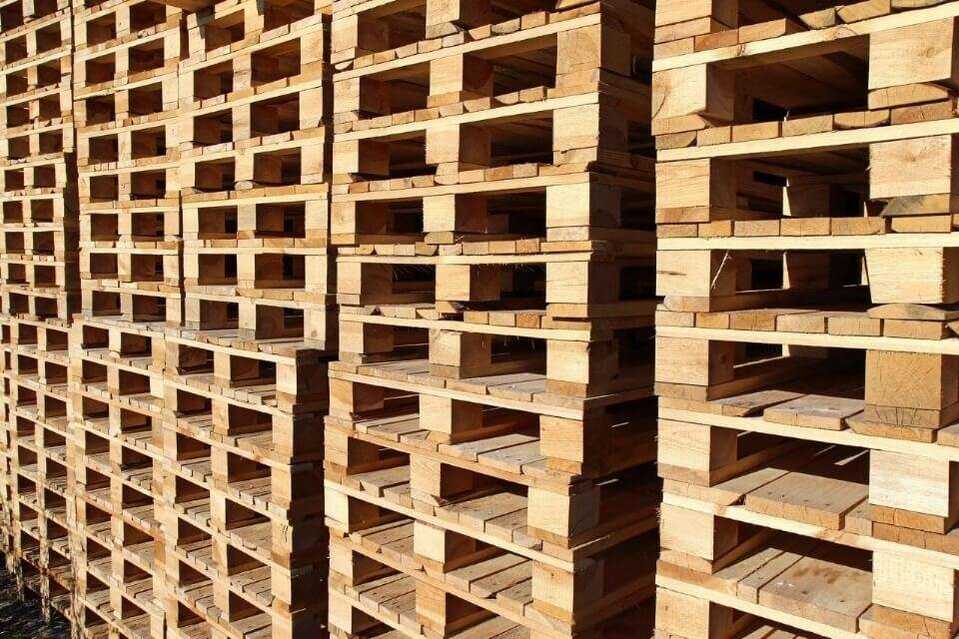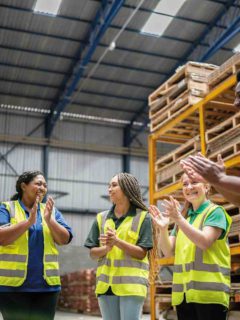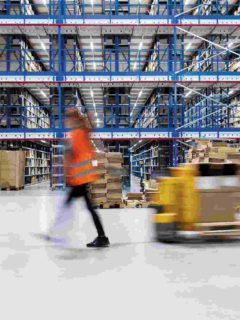Pallet-based sales and packaging are becoming increasingly popular in the logistics world. Saving time, space, budget and the environment, pallets significantly improve all processes in a logistics warehouse. However, to define your palletising strategy, you need to ask yourself the right questions and find the right equipment for your needs. This comprehensive guide will help you at every stage of your palletising process.

- Before you start: target your specific palletising objectives
- How to choose your pallet type?
- How to prepare a pallet?
- What equipment should be used to secure the pallet?
- How to choose a wrapping machine?
before you start: target your palletising objectives
Before you even begin to set up your processes, recognise the many benefits of palletising
- Protection of your goods: when you palletise your products, they are better protected and more stable.
- Optimisation of the filling of transport modes. With the pallet, you can store loads of up to 2500 kg. The larger the volume of goods, the more you save on your transport costs, so the process is interesting.
- Optimisation of storage space: A pallet takes up less space in a warehouse, whether permanent or temporary.
consider your palletisation goals now
- Do you want to transport goods that are sensitive to weather and outdoor conditions?
- Do you have limited pallet space or specific dimensions?
- Will your pickers have to handle high load pallets?
this will enable you to make the best choices for your process later on.
How do you choose your pallet type?
There are various crucial criteria for choosing your pallet type: formats, number of entries, maximum load, material, etc. Find out about all these criteria in detail.
What pallet formats are there?
In France, the law does not impose any standard dimensions on pallets. However, there are three types of handling pallets
- The EPAL pallet, also known as the EURO pallet. It has the “EUR” or “EPAL” logo on the top and measures 1200 x 800 x 145 mm as standard. These dimensions have been designed to minimise industrial packaging waste.
- The half-pallet: As the name suggests, it is half the length of an EPAL pallet, i.e. 600 x 800 mm. It is often multi-rotating: a relevant choice for the food industry and retail.
- The quarter pallet: 600 x 400 mm, easily nestable.
| You may have already heard of “American” or “ISO” pallets. These are mainly used in the USA, Japan and Canada and have dimensions of 1200 x 1000 mm. They are not at all suitable for European trucks. |

 how many entries should you choose?
how many entries should you choose?
The “number of entries” of a logistics pallet refers to the number of spaces where the handling forks can pass. Pallets with two entries allow the handling forks to pass only on 2 opposite sides of the pallet
Pallets with two entries allow the handling forks to pass only on 2 opposite sides of the pallet Pallets with four entries allow the handling forks to pass on all 4 sides of the pallet
Pallets with four entries allow the handling forks to pass on all 4 sides of the pallet
What is the maximum load of a pallet?
Logistics pallets have different maximum loads, which you must take into account when choosing them. To make the right choice, you must know how to differentiate between: Static load of the pallets: this is the maximum load that can be supported when the pallets are immobile on the ground.
Static load of the pallets: this is the maximum load that can be supported when the pallets are immobile on the ground. Dynamic load: this is the maximumload that apallet may
Dynamic load: this is the maximumload that apallet may
support
- Sturdy
- Stackable and rackable
- Suitable for export
- Recyclable and repackable
beware, however, that wood can be dangerous during handling.

 Cardboard pallets are less commonly used, but just as interesting. They are
Cardboard pallets are less commonly used, but just as interesting. They are
- Very light
- Stackable
- Suitable for export
- Economical and recyclable
with them, handling is safe for your employees and transporters.

 Plastic pallets can be of interest to logisticians who have to deal with special storage conditions. They are
Plastic pallets can be of interest to logisticians who have to deal with special storage conditions. They are
- Waterproof and resistant to temperature variations
- Rackable and stackable (depending on the model chosen)
- Suitable for export
- Washable
their handling is safe for operators

 Moulded pallets are the most environmentally friendly pallets on the market. They are
Moulded pallets are the most environmentally friendly pallets on the market. They are
- Economical
- 80% recycled and recyclable
- Lightweight
- Nestable
- Suitable for export
- Resistant to temperature variations
 leur manipulation est sécurisée pour opérateurs et transporteurs.
leur manipulation est sécurisée pour opérateurs et transporteurs.

Comment préparer une palette ?
Une fois vos palettes sélectionnées avec attention, il s’agit pour vos opérateurs de bien palettiser les produits, de manière stable et sécurisée. Établissez dès maintenant votre process de palettisation avec eux, grâce à ces quelques étapes.
Choisir une caisse palettisable
Une caisse palettisable a, par définition, des dimensions adaptées aux palettes standards disponibles sur le marché.
En sélectionnant une caisse palettisable, vous faites en sorte que les caisses seront bien stables sur votre palette logistique.


Répartir les cartons sur la palette
Il existe des règles optimales d’empilage des cartons sur la palette. Leur objectif : vous assurer que l’emballage final sera bien stable, prêt à être manutentionné.
La première étape consiste à remplir
- The heaviest and smallest boxes should be at the bottom of the pallet, and the lightest ones can then be placed on top of them.
- The top of the pallet should be as flat as possible. The aim is to make the different pallets easily stackable, thus optimising the space available in containers and trailers, and avoiding transporting empty space.
.jpg) For pallets that are as flat as possible, use a pallet cover: this will protect the top of your packaging in the best possible way.
For pallets that are as flat as possible, use a pallet cover: this will protect the top of your packaging in the best possible way.
Protecting your pallets in the best possible way
Packing a pallet efficiently also means choosing the right materials to protect it: here are our expert solutions for this. Think about placing corner protectors on your pallet. These cardboard wrappings protect the corners of the pallet from bumps and scratches, and ensure safe transport.
Think about placing corner protectors on your pallet. These cardboard wrappings protect the corners of the pallet from bumps and scratches, and ensure safe transport. Next, you need to film your pallet. There are two possibilities for doing thisFilming the pallet by handto do this, don’t forget to use the appropriate equipment, from the wide range available on the market.Opt for a wrapping machine. This equipment is recommended if you wrap more than 15 pallets per day, to prevent Musculoskeletal Disorders (MSD) among order pickers
Next, you need to film your pallet. There are two possibilities for doing thisFilming the pallet by handto do this, don’t forget to use the appropriate equipment, from the wide range available on the market.Opt for a wrapping machine. This equipment is recommended if you wrap more than 15 pallets per day, to prevent Musculoskeletal Disorders (MSD) among order pickers
3 mistakes not to make during palletising (and how to avoid them)
|


 quel matériel pour sécuriser la palettisation ?
quel matériel pour sécuriser la palettisation ?
Votre palette est conçue, remplie de vos marchandises… Avant de l’expédier, il s’agit désormais de la sécuriser au mieux, pour un transport sans encombres.
Pour cercler votre palette

Utilisez des feuillards pour cercler votre palette. En textile, en acier, en plastique… il en existe pour tous les besoins, sous forme de bobine compacte. Consulter l’article à ce sujet pour en savoir plus
Toute une gamme de machines, automatiques ou non, existent pour cercler la palette : leur choix dépend de votre budget et de vos besoins logistiques.

Le tendeur manuel aide les opérateurs à serrer la palette. Le but : qu’elle ne s’ouvre pas. Cet outil est pratique lorsque vous avez très peu de palettes à cercler quotidiennement ; en effet, un tendeur demande un certain effort à l’opérateur.

La cercleuse manuelle permetauxentrepôts aux petitsbudgets,
 if you need to film a large number of pallets at high speed, consider a polyethylene (PE) shrink film, which can be used with a shrink gun. Place the film on your pallet, then activate the gun: you will film the goods in record time.See the RAJA shrink gun if you need to film a large number of pallets at high speed, consider a polyethylene (PE) shrink film, which can be used with a shrink gun. Place the film on your pallet, then activate the gun: you will film the goods in record time.See the RAJA shrink gun |
to protect the pallet
 Pallet coverprotects the top of the pallet from the conditions in which the pallet is stored, as well as from dust after wrapping.
Pallet coverprotects the top of the pallet from the conditions in which the pallet is stored, as well as from dust after wrapping. Corner protectorsprotects the corners of your pallets from impact and reduces damage from strapping.
Corner protectorsprotects the corners of your pallets from impact and reduces damage from strapping.
How to choose a stretch wrapper?
Wrapping pallets is one of the most time-consuming activities in palletising. In addition, manual palletising, if often practised, exposes operators to risks of Musculoskeletal Disorders, such as rotator cuff tendonopathy.A stretch wrapper is a packaging machine that limits the physical effort of operators and increases efficiency during the palletising phase
| Think about the Simplified Financial Aid “Filmeuse+”Available for companies with less than 50 employees, this aid amounts to 50% of the amount of the investment and is capped at €25,000. Interesting, to limit RSI in your warehouse without breaking the bank.Learn more about AFS Filmeuse + |

La filmeuse à plateau tournant
Avec son plateau au sol, la filmeuse à plateau tournant demande plus de place au sol.
Pour des palettes hautes, vous pouvez rehausser le mât (jusqu’à 3,1 m).
Elle est éligible à l’Aide Filmeuse+.
 La filmeuse à bras tournant
La filmeuse à bras tournant
Plus chère que celle à plateau tournant, et ce à caractéristiques égales, la filmeuse à bras tournant, est fixée au sol. Lorsqu’elle est à l’arrêt, elle prend moins de place qu’un plateau tournant.
Elle permet de filmer des palettes de hauteur maximale de 2,75m.
Elle est éligible à l’aide Filmeuse+.

Le robot à banderoler
Vous filmez souvent des palettes hors Contrairement aux deux autres types de gabarit ? Le robot à banderoler sera idéal pour vous. Il permet aussi un gain de place par rapport aux autres machines : vous pouvez le ranger après son utilisation, mais aussi le déplacer où vous le voulez dans l’entrepôt.
Il n’est p
Think about the motorised pre-stretching optionOn all filming machines, you will find what is called the motorised pre-stretching carriage. It allows operators to use technical films from 150% to 400%. The principle: it is possible to stretch a film from 1m to 5m (for a 400% film), to save on the rate of use of film per pallet, without cutting back on the quality of the filming and the holding of the load. This option will be of benefit to you if
|
if you want to share these tips with your colleagues in PDF format, download the ultimate guide to starting or optimising your palletising process here.














